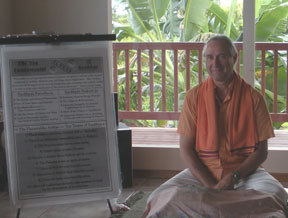
Oregon Kids Class
Last summer, Babaji set out a guideline for what our young teens should be learning. His list included the following charts, leaving it up to the kids' acharya to draw teachings from them in a suitable manner.
Here is a brief description of the charts and some explanation behind these choices, which will probably be useful for adults too:
- Akashas -- The Five Atmospheres -- This is a teaching about the 5 Atmospheres or kinds of space, from gross (bhutakasha) to the most subtle, which is pure Consciousness Itself (Chidakasha). It shows how the Self, which is all-pervasive Consciousness, "puts on" these different akashas like gross or subtle encasings. The chart was inspired by a comical but pointed story from the Yoga Vasishtha, wherein a hapless soul seeks one tightly fitting habitation in nature after another, all for the purpose of feeling safe and isolated. But nothing in nature lasts, and the poor jiva was driven from one to another, while the witnesses of his plight looked on wondering if he would ever understand that Consciousness needs no container.
- From Atomic Particles to Atmic Particles -- This chart lucidly connects the sciences of physical space to the inner sciences (metaphysics and spiritual) of the mind. It is very related to the Five Akashas chart, but emphasizes how all the subtle worlds/heavens are inside of us and how the entire universe comes out of us. It clarifies what happens in the states of dreaming, meditation and samadhi, as well as what the mind experiences upon death of the body. We used this chart last Spring when the children made sugar crystals -- an experiment to show how forms dissolve and reappear in nature.
- Causality, Origins & Reincarnation -- This chart presents crucial stages between the physical and the Absolute and is intent on unhooking the mind (or not letting it get hooked in the first place) from the idea that there are only physical causes and effects. The latter conclusion, endorsed by modern science, and tacitly or not so tacitly enforced by most educational and governmental systems, restricts conventional understanding to the one-lifetime scenario and its consequent physical-based view of human beings and their experiences. Babaji's Causation chart categorizes and traces the gross causes/effects to their more subtle origins, all the way to the Uncaused or Causeless Cause (Brahman).
- Kalpa - The Concept of Time in Vedic Cosmology -- This chart explains the Vedic perspective of time, from human years to the lifetime of Brahma, the "creator god." The point is for the children to enter into an expanded awareness of time that emphasizes its cyclical nature over vast eras, in contrast to the changelessness of the Self, which is the ultimate Witness of time and all things that happen in time, i.e. cycles of projection and withdrawal of forms, such as the lifetimes of humans, celestials, and Lord Brahma.
- Time and Enlightenment - This chart traces the stages of spiritual self-effort on up to enlightenment. The essential point of this chart is that the only thing worth seeking "in time" is enlightenment. When our mind gets unified and transcends time, all suffering, which is due to rebirth in the worlds of name and form, ceases.
- Aparinama -- The Principle of Nontransformation -- This chart represents the culmination of Babaji's intent with regard to what the children should be learning: that the Self is birthless, deathless and that no transformation takes place in It. Approached from the angles of time, space, and causation, this perspective should provide a foothold, at least intellectually, with which to practice a discerning analysis while moving through our contemporary society and the experiences of life. It is for this reason that one of the early "pass phrases" taught to the children is "nitya-anitya vastu viveka": Discrimination between the eternal and the non-eternal, or the more recent phrase: "That one attains immortality who intuits the Atman in and through every modification of the mind."
For openers...just to start us thinking deeply...and you can try these at home too:
Does it have an end?
Does it have a beginning?
Is time the same for everyone?
The Seers speak of Timeless Awareness - what do you think they mean?
In the Katho Upanisad, Yama (god of death) tries to dissuade the young Nachiketas from seeking the highest Knowledge by tempting him with thousands of years of life and celestial pleasures. Nachiketas refuses, saying they are all of short duration, prompting these questions:
In eternity, how would one measure the difference between the life of an ant and the life of Brahma (over 400 billion years)?
In answer to a disciple's question about how long it takes God to create the universe, Holy Mother responded, "Do you think He creates like a cookie maker? No, He creates all at once!" And that prompted this question:
How would birthless, deathless Reality see Time?
It is too bad we did not have a recording device running.
In the context of Arjuna's painful duty of leading his armies against wrongful rulers in a war everyone was unable to avoid, the children learned a new pass phrase. This is the very teaching Sri Krishna gave Arjuna to stabilize his restless mind and bring him back to inner peace.
The unreal has no existence, the Real never ceases to be.
Sat: Existence & Truth
The Sanskrit word for Truth is Sat. It is also the word for Existence.
Why do you think the words Truth, Real, and Existence are so related in Vedantic thought?
We devoted a good portion of our class time to unwrapping what Sri Krishna and the Seers mean by Sat and asat*. It is never too early to place these concepts out in the open to be grappled with. In the Itihasa there is the story of an awakened mother who daily sang to her infant lullabies affirming the child's nature as Atman and the importance of renunciation. This is another reason why we teach a few important Sanskrit words with each lesson: so the children become familiar with salient philosophical concepts so much needed as they enter adulthood.
*Sat: Real, Existence, True, not dependent on or caused by anything else. Asat: unreal, anything that undergoes change, anything that depends on or is caused by something else for its existence.
 Not just any domino theory........
Not just any domino theory........
We closed our lesson with a teaching on AUM, breaking it down for analysis using the teaching of the Four States of Consciousness: A for waking, U for dreaming, M for deep sleep, and the shvara (one-eyed smile) for Turiya, the Witness of all states that remains ever unaffected by the other three, even while being the substratum of those very experiences. This led to our class project:
The children formed the Sanskrit character for AUM on a table using dozens of domino tiles. This took a bit of skill since they had to be lined up in such a way that the three curves representing waking, dream, and deep sleep all fell down when the first domino was pushed. And the point? The shvara, was untouched and unaffected, being the "detached" witness of all the activities going on in those three states that are subject to time, space, and causation.
SRV EMAIL LIST
Receive news about SRV
Classes, Retreats, New Publications,
Nectar Magazine, and more.

